The Advanced document provides tools that allow you to remove migrated data from the destination server, reset a user’s status, clear a user’s history, remove a backend user record, and move the user back to the Audit/Notify/Match stage or forward to the Migrate stage.
|
|
|
Select Advanced in the Navigation Pane
Click Move to Audit/Notify/Match/Migrate to move selected users to previous or later stages of migration preparation:

Advanced View
Click Clear or Reset User(s) to reveal four menu options:
Clear or Reset User(s)
The following table describes each menu option.
|
Remove migrated data |
Description |
|---|---|
|
Remove migrated data |
Note: Data removal is designed to work on an Exchange server migration. If you remove items migrated to a .pst file, a 256k .pst file is generated. Simply deleting the .pst file is the preferred method for removing a .pst file.
|
|
Clear User History |
Note that this option is not available if using the Discovered History option
You may come across a situation where you need to migrate a user again; If you move the user back to the Preparation stage, and then migrate the user, the application will ensure that no duplicates are migrated; The application achieves this by maintaining a user log containing a list of the user’s messages that have been migrated; however, if you wish to start the migration process for a user afresh, you need to clear the user log;
The Clear User History button allows you to clear the migration history of a user; Before clearing the history and migrating the user again, be sure that the user’s messages on the Exchange server have been removed using the Remove migrated data option; otherwise, the process will copy all the user’s mail messages to the Exchange server resulting in duplicates
You can also right-click a user, select the Clear or Reset User(s) menu option, and then select the Clear User History submenu option to clear the cache of what has previously been migrated for the selected user(s)
Use this action to force a full migration on the user mail messages that have already been migrated |
|
Reset User(s) |
If a user has already been migrated, or partially migrated, or queued for migration, you can clear the Migrator for Notes memory of this event by using the Reset User(s) option; This action can be executed for a selected user
Right-click and select the Clear or Reset User(s) menu option, then select the Reset User(s) submenu option to clear all statuses from the selected users; Use this action to retry a user migration after resolving a problem |
|
Remove Backend User Record |
Deletes the user from the CMT_User SQL table; Note that when users are re-migrated after deletion, the previous migration history and assigned license is not retained |
Create a migration profile in the Set Migration Profile view
The migration profile controls what types of items are to be removed; for example, if you only select Calendar and Contacts in the Message Types field, then only Calendar entries and Contacts will be removed, and migrated mail will be left on the server. However, items are not removed based on the date the email was received or the date the event occurs on the calendar. When performing data removal, the date range specified in the migration profile only applies to the date the item was originally migrated.
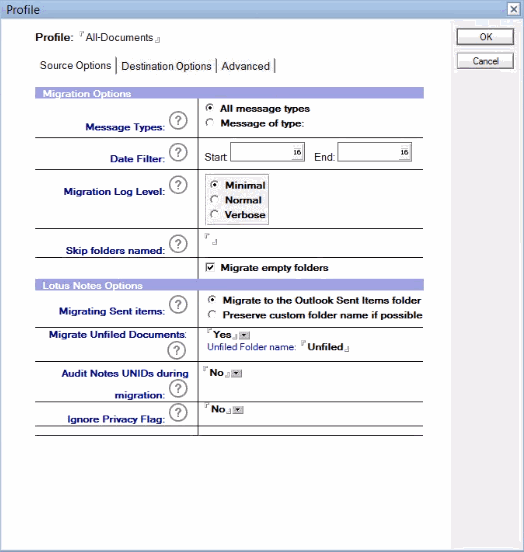
Creating a new Migration Profile
In the Migration | Set Migration Profile view, select the user whose data has been successfully migrated to Exchange and now needs to be removed from the destination server
Apply the migration profile to the user using the Set Migration Profile button and select the newly created migration profile from the list of profiles
Click the Migration | Advanced view. Select the user again, and click the Remove migrated data menu option from the Clear or Reset User(s) drop-down menu:

Advanced View – Remove Migrated Data
Select an option to migrate in the Select Remove Migrated Data Priority dialog box, and then click OK; the Exchange mailbox associated with the user opens and the previously migrated items are removed:

This will submit the account for migration worker to process the data removal. The status for this can be checked in the Migration | 2. Migrate view
The Rooms and Resources database consists of multiple calendars. You cannot migrate all Rooms and Resources at once because multi-calendar databases are not supported in Microsoft Exchange. For this reason, you need to import each room and resource from this database separately into the server.
The Rooms and Resource Import process will create individual nsf files for the migration of the specific calendar data for the entry to be migrated. The location of these nsf files can be configured on the Settings – Rooms & Resources tab.
|
|
The Excel import process cannot be used for Rooms and Resources because there is additional processing required to extract the specific calendar information for each room or resource from the Domino reservation application. |
|
|
The import and creation of the room or resource .nsf files with the extraction of the calendar data is a point-in-time process and will not automatically pick up changes to bookings after the import is completed. The items to be migrated should be imported as close to the migration time as possible. |
The Rooms and Resources database can be migrated either to a .pst file or to the Exchange server. Migrating the Rooms and Resources database to a .pst file is considered an easier method as it doesn’t require manually matching or resolving the database to the Exchange server.
In this section, you will learn to prepare the Rooms & Resources database for migration and migrate rooms and resources to a .pst file as well as to the Exchange server.
|
|
Irrespective of which method is employed to migrate the Rooms & Resources database, the preparation steps remain common to both the methods. |
To prepare for Rooms and Resources migration:
Expand the Rooms & Resources Migration | Preparation | Import and Copy view in the Navigation Pane:
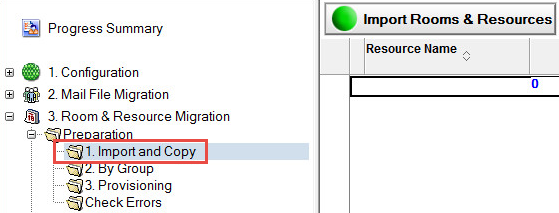

Source Count indicates the number of resources that might be necessary to migrate.
Click the Import Rooms & Resources button in the Data Pane:

Import Rooms & Resources
The Select Resource Type to Import from NAB dialog box appears; Room is selected by default; click OK:
The Rooms dialog box appears; select a room and click OK:
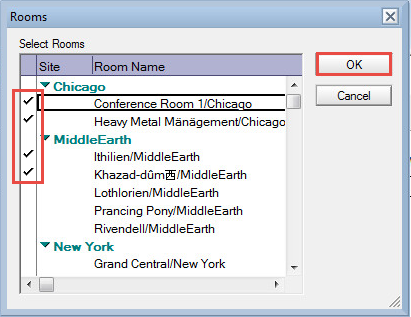
Rooms Dialog Box
A message box appears displaying the rooms you selected in the previous step; click OK to continue:

A confirmation box appears; click OK
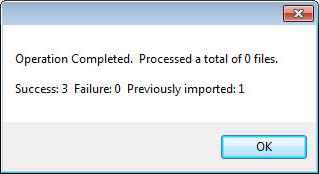
The Data Pane displays the rooms that are imported:

Click the Import Rooms & Resources button, select Resource and click OK to import from NAB:
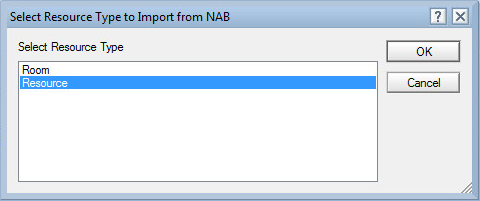
The Resources dialog box appears; select a room and click OK:
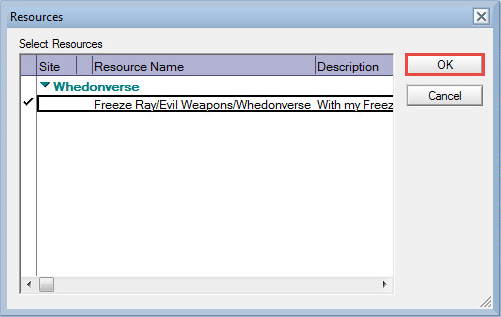
Resources Dialog Box
A message box appears displaying the resources you selected in the previous step; click OK to continue
A confirmation box appears; click OK
The Data Pane displays the resources that are imported
Rooms and Resources staging replicas can be created and managed if Replication is required and enabled. Note that Replication must be enabled and configured in the Replica Settings tab of Settings. Replication views do not appear if Replication is disabled.
|
|
|
To manage replication:
Expand Preparation and click Create Replicas
To create replicas, select one or more entries and click the Create Replicas button; this will create individual replicas; a Quick Push Replication option is also available in this view
You may clear and repopulate or delete selected databases from the Repopulate or Delete view if necessary:

Repopulate or Delete View
Click Compare All Replicas; the replica comparison will allow you to compare a room or resource and the staging replica
Select an option form the Verify Actions drop-down menu; a Quick Push Replication option is also available; click the Help button for more information about the replica comparison view:

The following table describes the function of each menu option:
|
Option |
Description |
|
Run Replica Comparison For Selected Users |
Allows you to select entries and compare replicas |
|
Set Verification Flag for Selected Users |
Allows you to select entries and set a verification flag for them |
|
Remove Verification Flag for Selected Users |
Allows you to select entries and remove the verification flag for them |
Click Preparation | By Group:

Set Migration Status By Group
This view gives you the ability set migration status and migration group
During the matching process, users that encounter an error are moved to the Check Errors folder in the Navigation Pane:
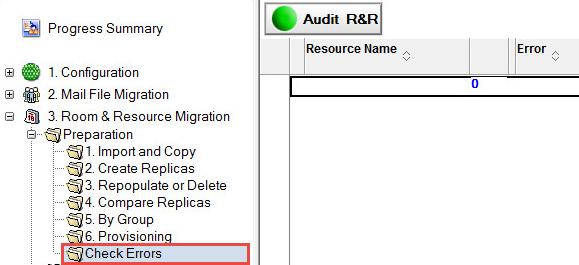
Check Errors View
|
|
If you cannot resolve the errors or need assistance determining why an error occurred, check the Knowledge Base under Support on the product web site or contact Product Support. |